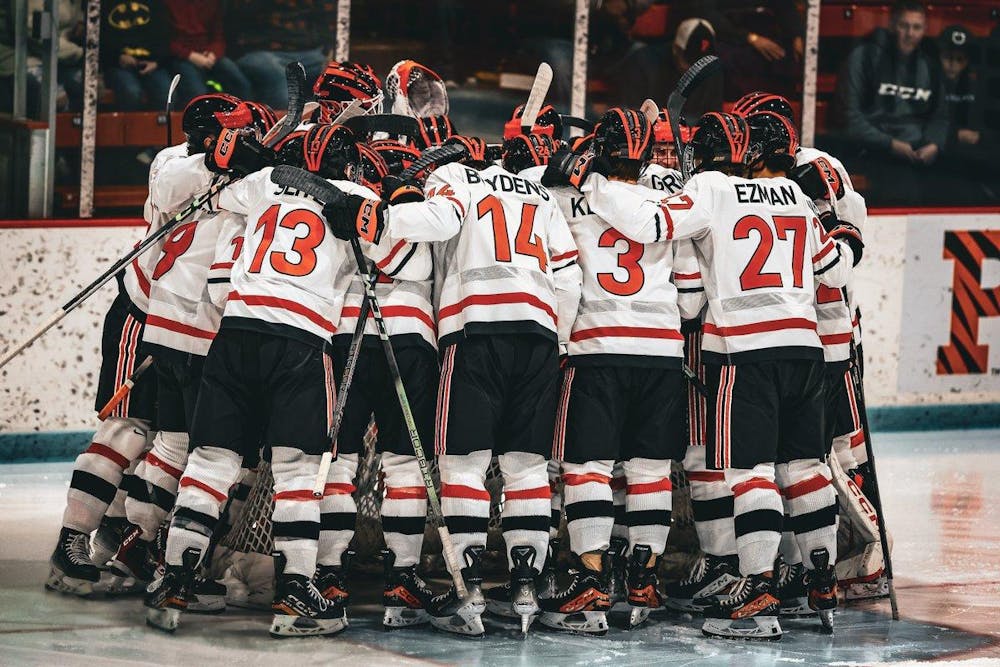Professional ice hockey player Adam Johnson’s tragic death by a skate blade to the neck during an Elite Ice Hockey League (EIHL) game in England on Oct. 28 sent ripples through the sport’s community. Due to the nature of Johnson’s injury, those in the ice hockey community have begun to question the safety of the sport that they love, including members of Princeton's own team.
Johnson was a former member of the National Hockey League’s (NHL) Pittsburgh Penguins. He registered one goal and three assists across 13 career games with the Penguins. Prior to moving overseas to play for the Nottingham Panthers, he also played with the Penguins’ American Hockey League affiliate, the Wilkes-Barre/Scranton Penguins. His recognizability within the sport contributed to the spike in safety concerns among the hockey community.
“The Adam Johnson stuff was kind of an eye-opener to where it’s like, okay, this is happening more and more often now. The last two times this has happened, both people have died,” senior forward for Princeton hockey, Joe Berg, explained to the Daily Princetonian. “Last year, there was a high school kid who also died from a neck cut."
As a result of these two recent public facing accidents, preventing skate laceration injuries has become an increasingly important topic of discussion within hockey circles. These conversations often take the form of debates around proposed neck guard mandates.
“The day after the incident occurred, during our first practice, I addressed the team and mentioned to them that if they wanted to wear neck guards, I’d more than support them,” head coach Ron Fogarty told the ‘Prince.’
As of early December, neck guards are only worn by one current Princeton Tiger: Joe Berg.
While different junior-level and youth hockey programs have moved to mandate neck guards in the last decade, most professional leagues and the college level have not — including the NCAA, which Princeton's Hockey team plays in. As a result, adult neck guards have never been a manufacturing priority. After Johnson’s death, the demand for adult neck guards skyrocketed, and the market could not keep up, leaving a shortage of neck guards and high prices for those available. Berg, anticipating this, quickly bought neck guards in the days after Johnson’s tragic death.
“I ordered two neck guards, like immediately after this happened. And I went to order another one the other day and they’re completely sold out,” Berg continued. “I don’t think it’s a ‘I don’t want to wear one’ thing from our guys. It’s more so that they don’t want to pay the 150 bucks for the compression long sleeve shirt with the neck guard on it.”

Though few, some junior and professional leagues have begun instituting neck guard mandates. Two major junior hockey leagues that frequently produce Division I and professional talent — the Canadian Junior Hockey League (CJHL) and the Western Hockey League (WHL) — have announced mandates that will go into effect when all teams obtain adequate supply. In addition, the International Ice Hockey Federation (IIHF) recently mandated the wearing of neck guards in all international competitions moving forward, including during the World Junior Ice Hockey Tournament, which began on Dec. 26. For USA Hockey, the NHL, and the NCAA, discussions surrounding the mandating of neck guards are expected to pick up in the coming months.
Hesitation among players to wear neck guards may be due in part to the issue of in-game comfort. Hockey players, and athletes in general, are often creatures of habit, wanting to change little about their pregame and in-game routines, even down to the equipment that they wear.
“When you put your hockey equipment on at the beginning of the year, you’re trying to break the equipment in, and it takes a couple of practices to get used to it,” Fogarty mentioned to the ‘Prince.’ “I would assume that without knowledge [of the neck guard] that it would take a couple of practices to become accustomed to it.”
Fogarty is nonetheless a supporter of neck guard mandates.

“I imagine that during the NCAA Coach’s Convention, at the completion of the season, it will be a topic of discussion. As far as the NCAA mandating the neck guards, I don’t know if they will. If they do, I would support it 100 percent,” Fogarty told the ‘Prince.’
For many players moving forward, the calculus around choosing to wear a neck guard is a lot simpler than before. As supply builds, it can be expected that more players, at Princeton and beyond, will begin wearing neck guards. Athletes like Joe Berg put it best: a small change in routine and comfort is not worth the risk of losing your life playing a sport.
“Now it seems like if you wear one, you’re definitely going to prevent the possibility of dying ... I’m gonna make my fiancé feel a whole lot better if I’m wearing it on the ice. I’m gonna make my parents feel better if I’m wearing it on the ice,” Berg explained. “And so when it came down to it, it seemed like a no-brainer to wear one.”
Cole Keller is a head editor for the Sports section at the ‘Prince.’
Please send any corrections to corrections[at]dailyprincetonian.com.








